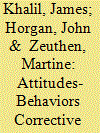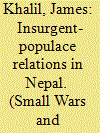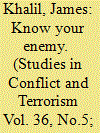|
|
|
Sort Order |
|
|
|
Items / Page
|
|
|
|
|
|
|
| Srl | Item |
| 1 |
ID:
188039


|
|
|
|
|
| Summary/Abstract |
This article responds to Clark McCauley’s commentary on our Attitudes-Behaviors Corrective (ABC) Model of Violent Extremism, in which he contrasts our framework with his own two pyramids model (developed with Sophia Moskalenko). In particular, we focus on further distinguishing between the “core” and “optional extra” elements of our ABC model, elaborating on how our interpretation deals with individuals who seemingly become involved in violence in the interests of the group, “unpacking” the concept of ideology through our ABC lens, and providing recommendations on how to measure attitudes and behaviors in a context specific manner.
|
|
|
|
|
|
|
|
|
|
|
|
|
|
|
|
| 2 |
ID:
188037


|
|
|
|
|
| Summary/Abstract |
Progress in understanding and responding to terrorism and violent extremism has continued to stall in part because we often fail to adequately conceptualize the problem. Perhaps most notably, much of our terminology (for instance, “radicalization”) and many variants of our existing models and analogies (including conveyor belts, staircases and pyramids) conflate sympathy for this violence with involvement in its creation. As its name suggests, the Attitudes-Behaviors Corrective (ABC) model seeks to overcome this issue by placing this key disconnect between attitudes and behaviors at its core. In this paper, we first present the key elements of our model, which include a graphic representation of this disconnect and a classification system of the drivers of violent extremism. The former enables us to track the trajectories of individuals in relation to both their attitudes and behaviors, while the latter helps ensure that we consider all potential explanations for these movements. We then adapt these elements to focus on exit from violence, applying the dual concepts of disengagement and deradicalization. Finally, we conclude with a section that aims to provide the research community and those tasked with preventing and countering violent extremism with practical benefits from the ABC model.
|
|
|
|
|
|
|
|
|
|
|
|
|
|
|
|
| 3 |
ID:
165307


|
|
|
|
|
| Summary/Abstract |
The quality of studies drawing primary data from terrorists and violent extremist respondents varies substantially, with this body of literature exhibiting a variety of repeating methodological issues. For instance, researchers often uncritically accept interviewee responses at face value, overlook key theoretical insights, downplay or neglect potentially important explanatory variables, fail to offer sufficient information about their sampling methods, and deliver findings with inferences beyond what their sample allows. Indeed, certain studies demonstrate a number of these flaws, including the United Nations Development Programme's recently published Journey to Extremism in Africa report. Within this context, the dual purposes of this article are (a) to discuss ways to overcome these specific methodological problems, and (b) to provide broader guidance for face-to-face research with such respondents.
|
|
|
|
|
|
|
|
|
|
|
|
|
|
|
|
| 4 |
ID:
111889


|
|
|
|
|
| Publication |
2012.
|
| Summary/Abstract |
The first objective of this article is to provide conceptual clarity regarding the term 'support' in the context of insurgent campaigns. While it is commonly claimed that insurgent and counterinsurgent forces compete for the support of the populace, there is often ambiguity as to whether this refers to a voluntary preference for a group of armed actors (attitudinal support), or a set of actions that provide direct benefits to one of these groups (behavioural support or collaboration). Furthermore, while a number of academics and practitioners focus upon the former on the assumption that it translates into the latter with sufficient consistency (Lawrence 'of Arabia', Mao, etc.), others maintain a contradictory stance (Kilcullen, Kalyvas, etc.). The findings from research undertaken into the 1996-2006 conflict in Nepal suggest a more complex reality in that certain forms of collaboration (e.g. provisions of information) seemingly necessitate supportive attitudes to a greater extent than others (e.g. supplies of food). The second objective is to evaluate the various approaches used by the Maoist insurgents to generate these distinct forms of support. While their ideology largely failed to resonate with the populace, attitudinal support was obtained through various 'popular appeals', including land reform, an opposition to an increasingly repressive monarchy, and campaigns to empower certain marginalised sectors of society. In contrast, the development initiatives of the Maoists, and their nationalist rhetoric in opposition to US and Indian influence were substantially less effective. Each of these initiatives were undertaken to obtain collaboration via attitudinal support, but the former was also generated directly through the use of coercion against specific non-combatants.
|
|
|
|
|
|
|
|
|
|
|
|
|
|
|
|
| 5 |
ID:
122411


|
|
|
|
|
| Publication |
2013.
|
| Summary/Abstract |
Academics and military analysts regularly attempt to distinguish terrorists from insurgents through focusing on the extent to which these adversaries (a) adopt nonviolent methods, (b) apply uncompromising forms of violence, (c) generate local support, (d) recruit and maintain manpower, and (e) control territory. In contrast, this article argues that attempts to distinguish between these adversaries inevitably fail, firstly, as they arbitrarily impose binary distinctions upon continuous variables (e.g., in levels of support, manpower figures), and secondly as there is a lack of agreement across these supposedly identifying characteristics. Thus, contrary to common wisdom, it is concluded that there is no contradiction in simultaneously labeling groups such as the Taliban and Al Qaeda as both terrorists and insurgents. Indeed, a complete understanding of these groups requires an assessment of their activities at both the tactical (as terrorists) and strategic (as insurgents) levels.
|
|
|
|
|
|
|
|
|
|
|
|
|
|
|
|
| 6 |
ID:
132220


|
|
|
|
|
| Publication |
2014.
|
| Summary/Abstract |
This article develops and elaborates on three core points. First, as with research into other social science themes, it is argued that it is necessary to apply the logic of correlation and causality to the study of political violence. Second, it highlights the critical disjuncture between attitudes and behaviors. Many or most individuals who support the use of political violence remain on the sidelines, including those who sympathize with insurgents in Afghanistan (reportedly 29 percent in 2011), and those supportive of "suicide attacks" in the Palestinian Territories (reportedly reaching 66 percent in 2005). Conversely, those responsible for such behaviors are not necessarily supportive of the ostensible political aims. Third, it is argued that the motives that drive these attitudes and behaviors are often (or, some would argue, always) distinct. While the former are motivated by collective grievances, there is substantial case study evidence that the latter are commonly driven by economic (e.g., payments for the emplacement of improvised explosive devices), security-based (i.e., coercion) and sociopsychological (e.g., adventure, status, and vengeance) incentives. Thus, it is necessary for the research community to treat attitudes and behaviors as two separate, albeit interrelated, lines of inquiry
|
|
|
|
|
|
|
|
|
|
|
|
|
|
|
|
|
|
|
|
|